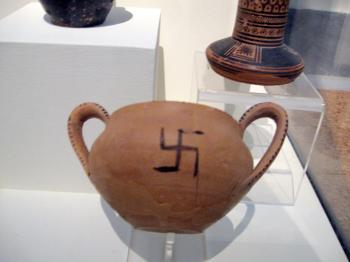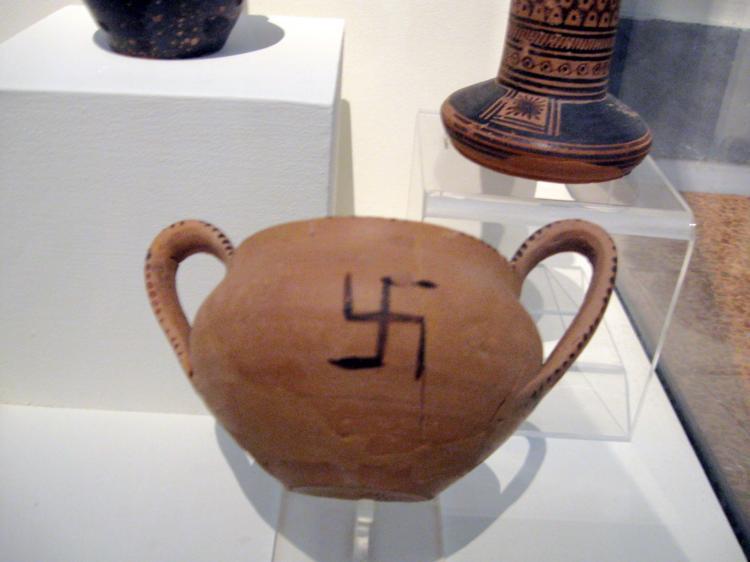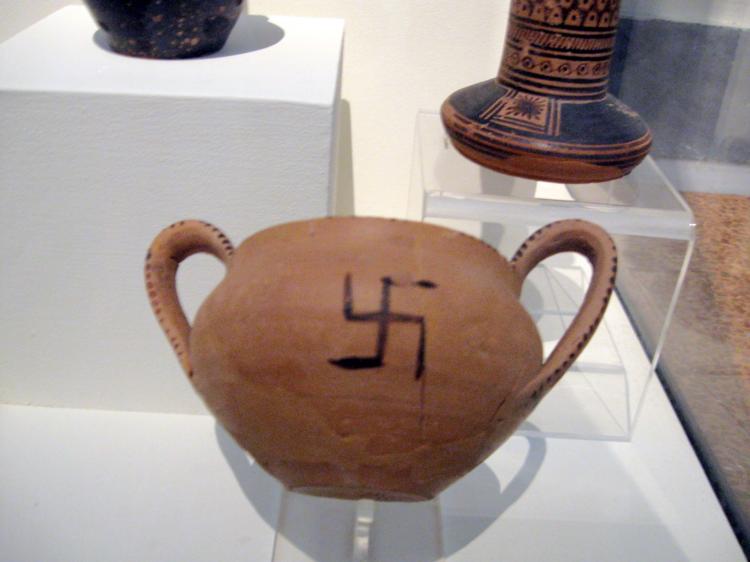For far longer than the post-war world popularly knew the swastika, it has been as symbol of wisdom and mercy. With a history of 3,000 years, the swastika symbol originates in ancient India and ancient Western cultures.
It represents the continuous movement—a movement like the movement of a windmill or a water mill. It continuously spins clockwise and counterclockwise. When it turns clockwise it represents the universe’s energy, strength, and intelligence; when it turns counterclockwise it represents mercy. It also represents universal harmony and the balance of the opposites.
The word “swastika” is Sanskrit and means “the self-manifested mark.” In other words, it is a sign of self-realization, and the mark of an enlightened person, otherwise known as a buddha. Thus buddhas depicted in artwork often bear the sign on their chests or palms.
The word swastika is generally believed to be an amalgam of the words “su” and “asati.” Su means “good” and asati means “to exist.” As per Sanskrit grammar, when the two words are amalgamated, they become Swasti. “-ka” is a suffix. If this derivation of the word swastika is correct, then the literal meaning of the word would be “let the good prevail.”
For Western cultures, such as the Greek, Celtic, Finnish, and various indigenous cultures, the swastika was also a very important symbol. It is used mostly in the area of art in clothing, architecture, pottery, and sculpture. Western cultures call it the wheel of light. In Chinese it is known as the “wan” symbol. “Wan” is a homophone for ten thousand, a number often used to encompass all of the universe’s creations.
When Adolf Hitler took the swastika to be his emblem, he wished to claim its universal power as his own. Since then, the modern world has associated the swastika with Hitler’s regime and ideology. In Germany, the symbol is still seen with a great deal of stigma. It’s time to return the swastika to its real position and recover its original meaning.
Read about the German court’s approval of the Swastika in 2004: http://en.epochtimes.com/news/4-9-4/23097.html
It represents the continuous movement—a movement like the movement of a windmill or a water mill. It continuously spins clockwise and counterclockwise. When it turns clockwise it represents the universe’s energy, strength, and intelligence; when it turns counterclockwise it represents mercy. It also represents universal harmony and the balance of the opposites.
The word “swastika” is Sanskrit and means “the self-manifested mark.” In other words, it is a sign of self-realization, and the mark of an enlightened person, otherwise known as a buddha. Thus buddhas depicted in artwork often bear the sign on their chests or palms.
The word swastika is generally believed to be an amalgam of the words “su” and “asati.” Su means “good” and asati means “to exist.” As per Sanskrit grammar, when the two words are amalgamated, they become Swasti. “-ka” is a suffix. If this derivation of the word swastika is correct, then the literal meaning of the word would be “let the good prevail.”
For Western cultures, such as the Greek, Celtic, Finnish, and various indigenous cultures, the swastika was also a very important symbol. It is used mostly in the area of art in clothing, architecture, pottery, and sculpture. Western cultures call it the wheel of light. In Chinese it is known as the “wan” symbol. “Wan” is a homophone for ten thousand, a number often used to encompass all of the universe’s creations.
When Adolf Hitler took the swastika to be his emblem, he wished to claim its universal power as his own. Since then, the modern world has associated the swastika with Hitler’s regime and ideology. In Germany, the symbol is still seen with a great deal of stigma. It’s time to return the swastika to its real position and recover its original meaning.
Read about the German court’s approval of the Swastika in 2004: http://en.epochtimes.com/news/4-9-4/23097.html







